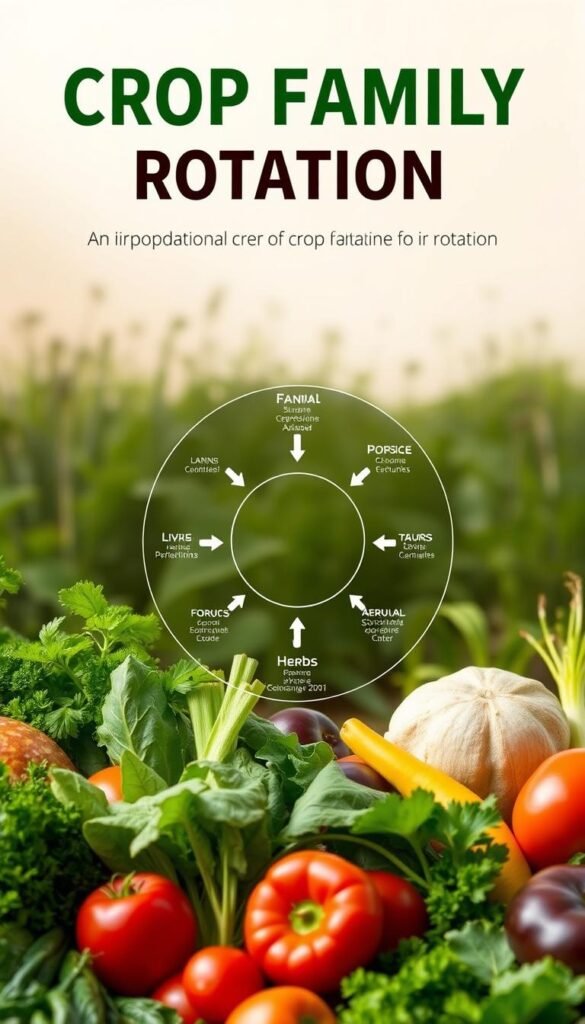Imagine your growing area becoming more productive each season while naturally fighting pests and building richer earth. Systematic plant family rotation offers exactly that – a proven method to revitalize your space without constant upkeep. By changing what grows where annually, you create balanced conditions that help plants thrive.
This approach solves common frustrations like nutrient depletion and recurring blights. Communities using organized systems report 30% fewer weeds and easier harvests compared to random planting. Earthworms and microbes flourish in these environments, boosting growth naturally over time.
Our guide simplifies implementing these strategies through logical sequences. You’ll discover how grouping compatible species maximizes yields while minimizing work. The system works beautifully with no-dig methods that preserve earth structure and moisture retention.
Beyond pest control, you’ll create self-sustaining conditions where each planting prepares the ground for the next. This foundation leads to consistent results season after season, letting nature do the heavy lifting while you enjoy abundant harvests.
Understanding Crop Rotation for Long-Term Soil Health

Crop rotation works like nature’s reset button, refreshing your garden each season. This ancient practice balances nutrients and keeps your earth thriving. By switching plant families annually, you break pest cycles and let the ground recover naturally.
Benefits of Rotating Crop Families
Different plants use resources in unique ways. Leafy greens drain nitrogen, while peas and beans add it back. Following heavy feeders like tomatoes with light users like basil creates a self-sustaining rhythm. Deep-rooted carrots loosen compacted earth, while onions protect top layers from erosion.
Farmers using organized systems see up to 25% bigger harvests. Your dirt becomes richer over time as roots feed microbes and worms. This diversity also stops diseases from settling in—like how moving broccoli beds confuses flea beetles.
How Crop Rotation Reduces Pests and Diseases
Insects specialize in specific plants. When you shift crops yearly, pests lose their food source. For example, rotating potatoes away from tomatoes breaks fungal spore cycles. Studies show this method cuts chemical treatments by half in some cases.
Planning rotations gets easier with tools. Try rotating crops in tight spaces using simple charts. You’ll save money on fertilizers and enjoy healthier plants that naturally resist invaders.
Assessing Your Garden’s Unique Conditions

Your plot’s personality determines what thrives there. Start by getting to know its quirks—like a farmer studying their land. Simple observations now prevent headaches later when rotating crops.
Evaluating Soil Type and Quality
Dig deeper than surface appearances. Test kits reveal your earth’s pH balance—most vegetables prefer 6.0-7.0. Sandy ground drains fast but needs extra compost. Clay holds nutrients tightly, though roots struggle to push through.
Organic matter acts like a sponge in gritty soils. For dense clay, mix in coarse sand to improve drainage. Annual testing tracks changes from previous plantings, showing where to adjust amendments.
Identifying Your Climate Zone Constraints
Your location’s weather patterns set the rhythm. USDA zones tell you which perennials survive winter, while frost dates define planting windows. Track sun exposure—south-facing beds warm faster in spring.
Microclimates matter too. Low spots stay frosty longer, while slopes dry quickly. Use this knowledge to match crops with ideal spots. Pair cold-hardy greens with shady areas, or heat-lovers with sun-trapping walls.
Need help timing plantings? Our seasonal care guide simplifies year-round scheduling based on local conditions.
Designing a Crop Family Rotation Plan

Smart crop rotation starts with knowing your plant relatives. Botanical families hold the secret to balanced soil and pest-resistant beds. When you group similar species together, you create predictable patterns that simplify yearly planning.
Grouping Plants by Botanical Families
Seven key families form the backbone of your rotation strategy:
- Nightshades (tomatoes, peppers): Heavy nitrogen users
- Cabbage relatives (kale, broccoli): Attract similar pests
- Legumes (beans, peas): Natural soil enrichers
These groups share feeding habits and vulnerabilities. Planting them in blocks lets you manage nutrients efficiently and disrupt pest life cycles.
Organizing Logical Sequences for Nutrient Balance
Follow this three-step pattern for self-renewing soil:
- Start with hungry crops like corn or squash
- Shift to moderate feeders like onions
- Finish with soil-building plants like clover
This sequence mirrors natural succession while preventing depletion. Pair it with square foot garden planning for precise space management.
Color-code your garden map to track family locations year-over-year. Bright markers for nightshades, cool tones for legumes – your future self will thank you during planting season.
Stress-Free Garden Planning: Rotational Schedules for Soil Health

Transform your growing space into a self-renewing ecosystem using nature’s calendar. A well-designed schedule aligns planting phases with earth renewal cycles, creating vibrant crops without exhausting your dirt. Start by mapping key seasonal tasks:
- Spring: Prep beds with compost tea before heavy feeders like corn
- Summer: Sow nitrogen-fixing clover between harvests
- Fall: Protect exposed earth with shredded leaf mulch
- Winter: Plan next year’s layout using color-coded zones
This rhythm keeps nutrients flowing while preventing erosion. One urban gardener shared:
“Tracking growth stages on a wall calendar cut my weeding time in half. The dirt feels alive now!”
Match your schedule to local frost dates and rainfall patterns. Short-season areas might cycle radishes and spinach twice yearly, while warmer climates can stagger bean plantings. Use free apps to set reminders for crop transitions and soil tests.
Here’s a simple three-month sequence for beginners:
- Weeks 1-4: Plant quick-growing lettuce
- Weeks 5-8: Follow with root vegetables
- Weeks 9-12: Rest the bed with mustard greens
These small rotations build organic matter while disrupting pest habitats. Your ground becomes richer each cycle, supporting bigger yields with less effort. Pair this system with seasonal care practices for maximum results.
Creating a Visual Garden Map for Easy Rotation Management
Turn your planting strategy into a colorful roadmap that guides every season’s growth. Clear visual organization helps you spot patterns and avoid repeating crops in the same zones. Whether sketching on paper or using apps, your map becomes the command center for healthy rotations.
Utilizing Digital Garden Planning Tools
Modern apps transform complex rotations into drag-and-drop simplicity. Popular programs like Garden Planner let you:
- Design beds with precise measurements
- Set automatic reminders for crop shifts
- Generate planting dates based on your ZIP code
One gardener noted:
“The app flagged where I’d grown tomatoes twice – saved my blight-prone beds!”
| Tool | Best Feature | Platform |
|---|---|---|
| Garden Planner | Pre-loaded crop families | Web/Desktop |
| Planter App | Companion planting alerts | iOS/Android |
| SmartDraw | Custom grid templates | All devices |
Color-Coding Beds for Quick Reference
Assign shades to plant families using cheap plastic markers or digital labels. Try this system:
- Red: Nightshades (tomatoes, peppers)
- Green: Leafy crops (spinach, kale)
- Blue: Root vegetables (carrots, beets)
Update your square foot layouts annually using colored pencils or app layers. This method reveals overcrowded areas before seeds hit dirt.
Implementing a Multi-Year Rotation Strategy

Long-term success in your growing space hinges on strategic timing. Multi-year plans let earth recover fully while disrupting pest lifecycles. Let’s compare two approaches: a thorough 7-year cycle and a streamlined 3-year version.
Exploring a 7-Year Rotation Plan Benefits
This extended strategy creates nature’s perfect recovery rhythm. Each season builds on the last, creating compounding benefits:
| Year | Crops | Key Benefits |
|---|---|---|
| 1 | Lettuce + Peas | Nitrogen boost |
| 2 | Tomatoes | Uses stored nutrients |
| 3 | Carrots | Breaks up compacted earth |
| 4 | Garlic | Natural pest deterrent |
| 5 | Squash | Shades out weeds |
| 6 | Kale | Heavy feeder |
| 7 | Clover | Soil restoration |
The final year’s soil restoration phase prepares beds for renewed productivity. This method works best for larger spaces where you can dedicate zones to specific crop families.
A Simple 3-Year Rotation Overview
Short on space? Try this effective cycle:
- Year 1: Plant hungry crops like corn
- Year 2: Switch to cabbage family plants
- Year 3: Grow beans to replenish nutrients
One gardener shared:
“The three-year method doubled my bean harvest while eliminating tomato hornworms!”
Both systems thrive when paired with 7-step rotation planning. Choose based on your plot size and how far ahead you want to plan.
Managing Seasonal Transitions and Soil Amendments
Mastering bed transitions unlocks your garden’s full potential. These critical moments between plantings determine whether your earth stays vibrant or loses steam. With smart timing and organic boosts, you create a seamless handoff between crops.
Preparing Beds Between Crop Changeovers
Start by clearing every leaf and stem after harvest. For tomatoes or broccoli, dig out roots completely—they can harbor diseases. Spread 2-3 inches of compost to feed microbes and restore nutrients. This step works especially well in raised bed setups where drainage supports quick recovery.
Incorporating Green Manures and Cover Crops
Fill empty periods with fast-growing plants like clover. These living blankets protect bare soil from erosion while adding organic matter. Chop them down just as flowers form, then mix into the earth. Buckwheat works wonders in 6-week gaps—it suppresses weeds and attracts pollinators.
Time your green manure plantings 3 weeks before new crops go in. This gives decomposed plants time to release nutrients. You’ll notice earthworms multiplying and compost breaking down faster in prepared beds. It’s nature’s way of prepping your next harvest!






